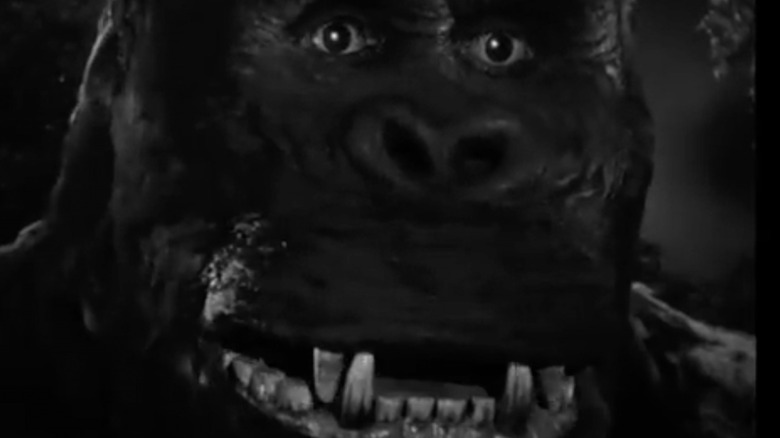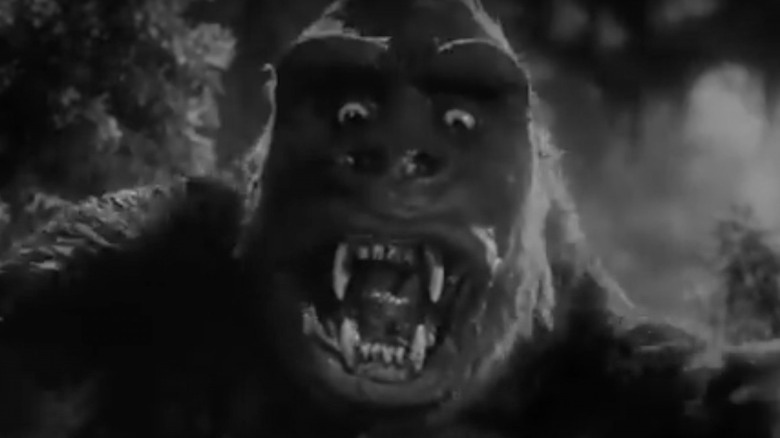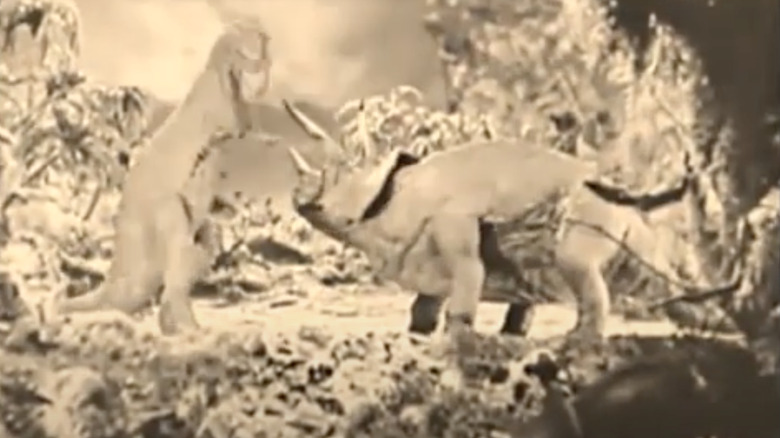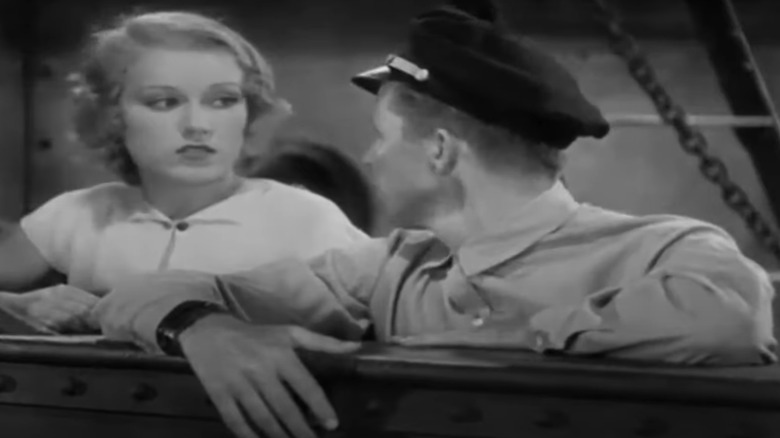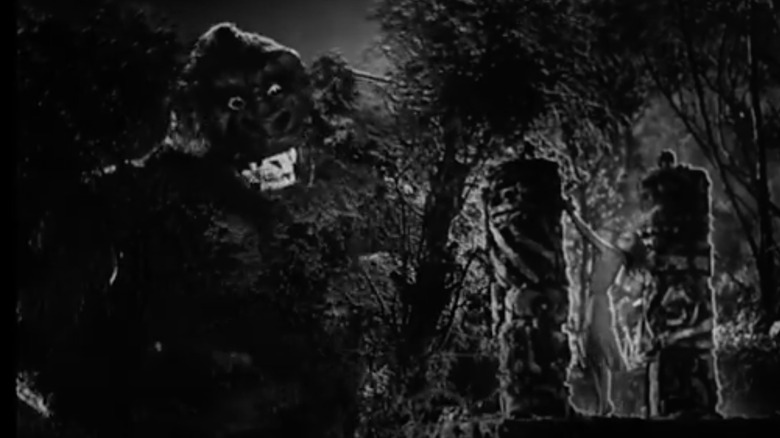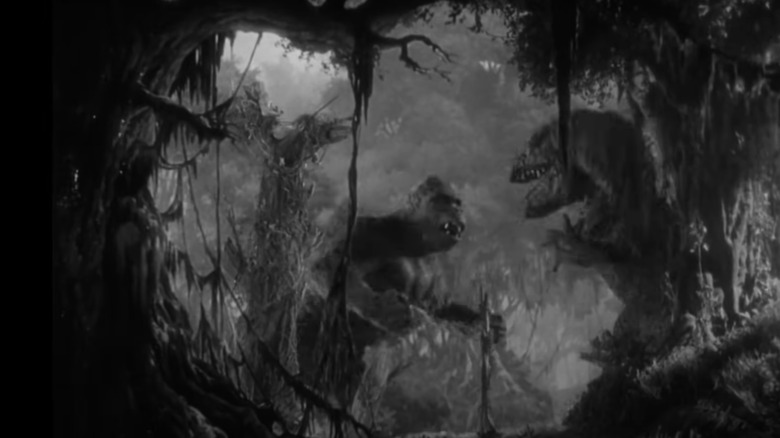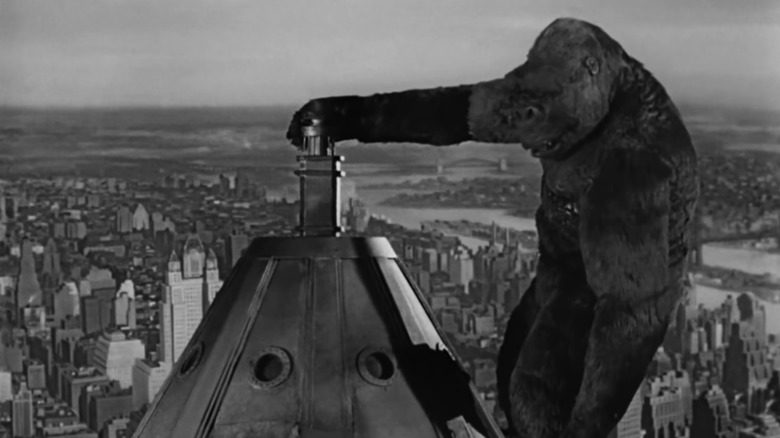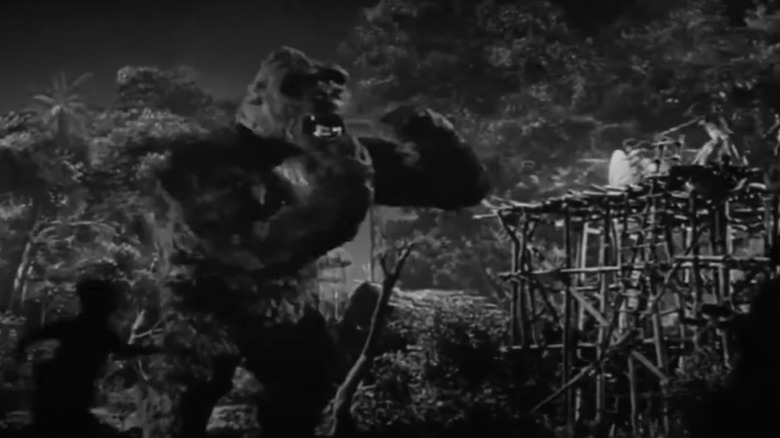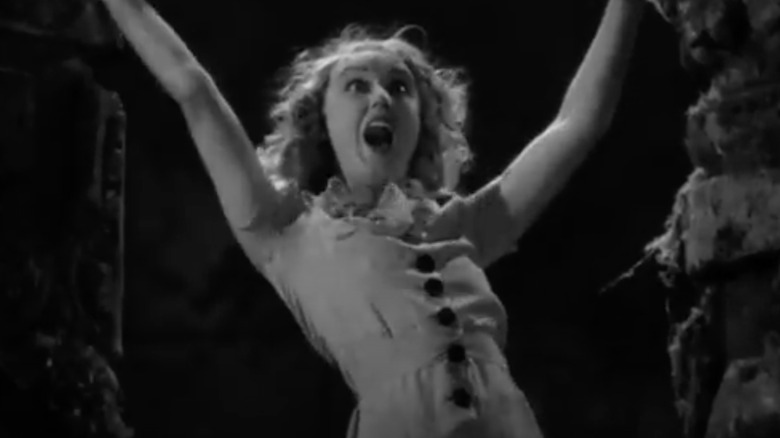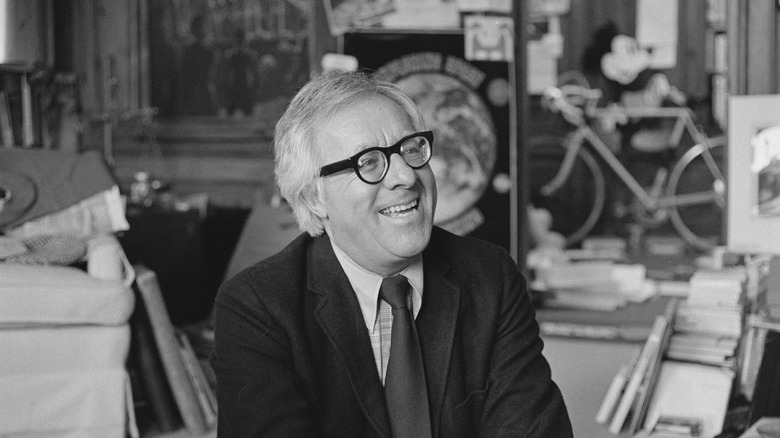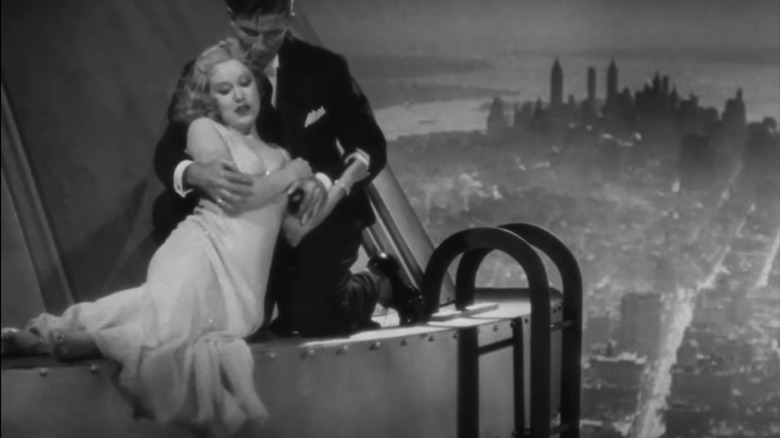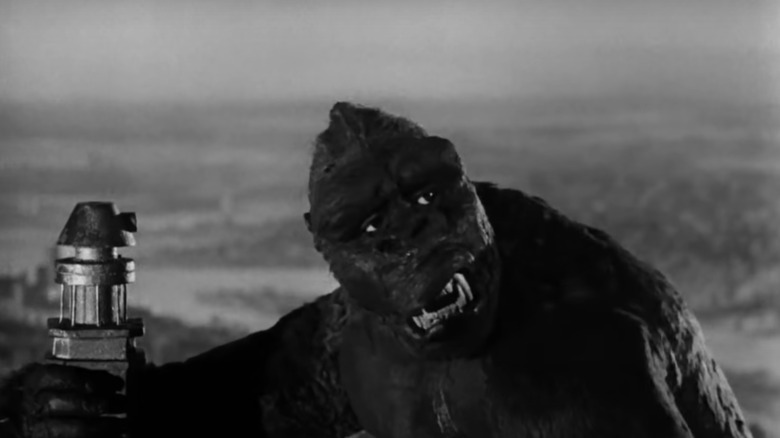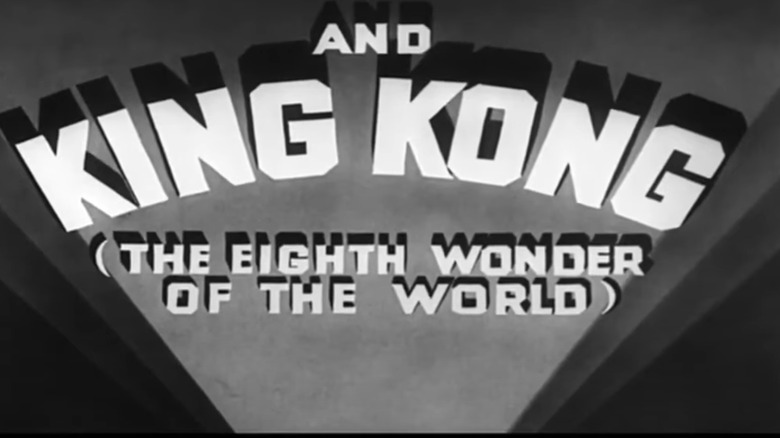What It Was Really Like To See King Kong In 1933
He was called the eighth wonder of the world — and indeed, when "King Kong" was released in 1933, he was a sight to behold.
The country was still suffering from the Great Depression when "Kong" was unleashed on March 2, 1933, but people were willing to line up and spend what little money they had to see this epic spectacle of a giant ape taken from captivity who falls in love with a beautiful blond starlet and meets a spectacular end atop of the Empire State Building. There were many great moments in "Kong" that have stayed with film fans ever since, whether it's the big ape swatting airplanes, Fay Wray screaming, or the incredible Skull Island, filled with dinosaurs and other giant creatures.
It's not that far-fetched to say that "Kong" was the "Star Wars" of its time because it was a state-of-the-art special effects movie that like any great magic trick made audiences wonder how they did all those incredible tricks. It also has to be mentioned that "Kong" was an original creature that was not based on a novel, comic book, or previously known story. "King Kong" was more than just special effects, action, and giant beasts. "Kong" worked on much deeper levels, which is one of the reasons why the story still endures after all this time. Here's what it was like to see "King Kong" when it was first released in 1933.
How Kong was created
"King Kong" was the creation of Merian C. Cooper, a man who had a varied background, and he brought a lot of his life experience into his work. Cooper was a fighter pilot, and he met his partner Ernest Schoedsack while working together at The New York Times.
Cooper brought a much different background to Hollywood, and he drew on his experiences in the jungle wild as the inspiration for "Kong." Cooper was especially fascinated by gorillas, and he learned a lot about Komodo dragons, which inspired some of the giant creatures that dwelled on Skull Island.
Before "Kong" there were already similar stories of explorers going to islands full of dinosaurs and giant creatures. Jules Verne created stories like "Journey to the Center of the Earth," Arthur Conan Doyle wrote "The Lost World," and Edgar Rice Burroughs wrote "The Land That Time Forgot," as well as the wildly successful "Tarzan" series. These stories showed Cooper how to create his own jungle story with giant beasts. ("The Lost World" also had dinosaurs rampaging through London, much like Kong would go berserk in New York.)
The Willis O'Brien backstory
Willis O'Brien, who created the incredible VFX for "Kong," is considered the godfather of stop-motion animation.
A native of Oakland, California, Willis was a skilled cartoonist, sculptor, and even a paleontology assistant, which all came together to create his art. O'Brien first did a short film, "The Dinosaur and the Missing Link" in 1915. Even though it was only 15 minutes long, it took two months to make because stop motion is very time-consuming. In 1918, O'Brien took a big step forward with "The Ghost of Slumber Mountain," where he brought stop motion and live-action footage together, convincing audiences that these magical creatures could exist in the real world. The film was also a big hit, reportedly making $100,000 on a budget of about $3,000.
O'Brien made yet another big step forward with "The Lost World," where stop motion was used in a feature-length film. Cooper and O'Brien met while working at RKO, and they originally worked on a movie called "Creation" together, which was never completed, but it laid the groundwork for "Kong."
Kong opened during the Depression
"King Kong" opened on March 2, 1933, when the country was still in the grips of the Great Depression. As it turns out, a lot of classic monster movies were released during the Depression, including the original "Dracula" and "Frankenstein," which made stars of Bela Lugosi and Boris Karloff respectively.
As we've seen throughout history, audiences love going to the movies in times of trouble, and "Kong" transported audiences to a different world when the outside world was in turmoil. While it may seem odd that audiences would go to monster movies during scary times, it gave audiences a way to scream and let out their fears together in a safe environment, knowing the scares will be over in two hours. "King Kong" made $90,000 on opening weekend, which was a record for the time, and a great sum of money for a movie to make in the '30s.
Why Kong was a state of the art movie for its time
Today's audiences are very tech-savvy, and they understand that these days special effects are largely created with computers. Back in 1933, audiences didn't know how special effects were created. "King Kong" was such a groundbreaker that audiences believed they were taken to a real, three-dimensional jungle full of dinosaurs and giant beasts.
While stop-motion is a simple technique by today's standards, "King Kong" took stop-motion to a new level. It took over a year for O'Brien to animate the film, just as movies today usually have long post-production periods for FX that often go down to the wire. (Stop-motion master Phil Tippett once explained that doing stop-motion animation requires great concentration, and to get a 150-frame shot, which can take up six seconds of screen time, can take anywhere from six to 12 hours.)
It's also important to remember that movies had only just entered the sound era several years before "Kong" was created. In 1927, audiences flocked to theaters to hear Al Jolson sing in "The Jazz Singer," so a grand spectacle like "Kong" was really something remarkable for audiences to witness at the time.
How Kong's FX convinced audiences that Kong's world was real
When great special effects innovations come along, they can convince audiences that what they're seeing on the screen is real, no matter how far-fetched it would seem in real life. "Star Wars" took you to another world, and "King Kong" took audiences to an incredible jungle island full of giant beasts, dinosaurs, and danger. It wasn't just the special effects that convinced audiences, it was how they were all brought together that convinced them that what they saw was believable. Not only did Kong seem real to moviegoers, but so did his home.
As One Hundred Years of Cinema explains, "What made 'Kong' so special was how it combined effects, under the direction of O'Brien, to create a larger feeling, more realistic world. To create the illusion of a dense jungle, O'Brien combined glass paintings, physical miniature models, and matte paintings to give Skull Island incredible depth. [It] put Kong in a realistic, three-dimensional world."
In creating the special effects for "King Kong," Willis O'Brien brought other important techniques together, including traveling matte shots and rear-screen projection. The camera also moved around "Kong," which brought more life to the creature (In "The Lost World," the camera stayed stationary during the stop motion scenes.)
It's also remarkable to think that Kong was an 18-inch miniature, but O'Brien was so skilled at moving him around that audiences believed he was a real creature. The Kong model had 100 moveable joints, and it was all the little movements and nuances that really brought the creature to life.
How Kong laid the groundwork for modern FX
"King Kong" was a big special effects movie for its time, and it helped lay the groundwork for the special effects industry to come, especially considering it inspired many people to become FX artists when they grew up. When cinema was still developing and growing in the early 20th century, "Kong" was one of the films that showed what special effects were capable of, and it inspired many artists to keep pushing technology forward for decades.
Many of the key special effects techniques seen in "Kong" would be repeated and refined throughout cinema history, especially matte paintings, miniature models and sets, realistic rear screen projection, and combining live action and animation together. Decades later, companies like ILM would build on these techniques in new high-tech ways on films like "Star Wars," but with the original "Kong," it's clear how early FX techniques laid the foundation for future innovations.
How Kong's box office success repeated throughout history
Looking back on cinema history, we can see where future blockbusters owe a debt to "Kong."
Blockbusters often blend a lot of different story elements together so they can appeal to the biggest audience possible. "Kong" wasn't just a monster movie, it was also a great adventure, a love story, and a tragedy that could have been something out of Shakespeare (like "Romeo and Juliet," Kong and Ann are star-crossed lovers that could never be, no matter how deeply they fell for each other).
As we saw in another big creature movie, "Jaws," Steven Spielberg combined a lot of elements together — action, drama, horror, and comedy. Even though "Jaws" scared audiences silly, it still appealed to a wide audience, and it was the most successful movie of its time until it was dethroned by "Star Wars" two years later.
RKO spent lavishly on advertising for "Kong," even when there wasn't much money to spare. (Some theaters even redid their lobbies to look like jungles.) As we saw after "Kong," many blockbusters would spend fortunes on advertising, and the original "Kong" did a big advertising push with "Kong" related novelizations, radio dramas, comic strips, and more.
Kong snuck in scares and sexiness before the Hays Code
When "Kong" was released in 1933, it gave audiences scares and some sexiness long before we had a rating board. But in the '30s, there was the Hays Code.
Will H. Hays presented a lengthy list of rules for movies that forbade nudity, onscreen adultery, homosexuality, illegal drug use, and so much more. While the Hays Code was invented in 1930, it wasn't really enforced until 1934, making "Kong" a "pre-code" picture.
There's of course sexual tension between Ann Darrow and Kong, with Kong dominating her and playing with her dress while she's bound as a sacrifice. In fact, when "Kong" was re-released in 1938 when the Code was in full effect, some scenes had to be cut down, including Kong taking off Wray's clothing, natives getting stomped under Kong's feet, and a woman being thrown to the ground by Kong in New York. This footage could finally be seen again in the early '70s.
Kong inspired two great Rays when they first saw it
When a movie comes out today, there are audience reactions all over the internet with fans ranting or raving about it. Obviously, we didn't have the internet in 1933, but two of Kong's biggest fans, Ray Bradbury and Ray Harryhausen, vividly recalled the impact "Kong" had on them as master creators.
Bradbury became of the most important authors of the 20th century ("Fahrenheit 451"), and Harryhausen became arguably the greatest stop motion FX artist in cinema history. Both were blown away and wonderfully inspired by "Kong" when they saw it together.
"King Kong" ignited the imagination of many kids who went on to make their own fantastic films. As Bradbury recalled years later, after watching "King Kong," "A mob of boys went quietly mad across the world then fled into the light to become adventurers, explorers, zoo-keepers, filmmakers."
And Harryhausen knew the path he wanted to take as a stop motion animator after watching the marvel of "Kong," As he recalled, "I didn't know much about stop motion at the time when I saw 'The Lost World,' 'King Kong' was the one that did it. It sent me spinning out of Grauman's Chinese in a tailspin. I haven't been the same since."
Kong's reviews, then and now
When "Kong" was released in 1933, critics were a bit more skeptical than the average audience, but they were still clearly impressed by the film.
As Variety reported, "'Lost World' is the only picture to which 'Kong' can be compared ... But 'Kong' is the better picture. It has the additional advantage of sound, which 'Lost World' missed in 1925 ... 'Kong' surpasses anything of its type which has gone before it in commercial film-making. The work has many flaws, but they're overcome by the general results. The errors will probably be overlooked."
Variety added that "It takes a couple of reels for Kong to be believed," but once the audience gets into the fantastical world, "it reaches a high pitch of excitement and builds up to a thrill finish in which the ape almost wrecks New York. Audiences will wonder how it's done. If they wonder they'll talk, and that talk plus the curiosity the advertising should incite ought to draw business all over."
Today "Kong" has a very high rating on Rotten Tomatoes by both critics and audiences alike. Matt Brunson of Film Frenzy writes, "In much the same manner as 'The Wizard of Oz' and 'It's a Wonderful Life,' this masterpiece long ago entered into the national consciousness as an enduring part of our heritage." Luke Parker of VoiceBoxOffice also wrote, "What's impressive is that even though Kong looks a little wonky now, you're still able to latch onto the character."
Why Kong is really the hero
Kong is a giant, powerful monster, but in many great monster films, the beast is often the good guy while man is the real villain. In "Frankenstein," "Creature From the Black Lagoon," and "Kong," the creatures were manipulated and exploited by man. In both "Creature" and "Kong," the monster's environment is invaded by man, and "Kong" is exploited back in human civilization.
When Peter Jackson saw "Kong" on TV at the age of 9, he shed a tear at the end, and many fans would have a similar reaction. As Jackson told NBC, "There's something incredibly tragic about Kong. You almost feel ashamed to be a human being when you see what happens to him. He is ultimately a pure-heart."
Jackson added, "People call Kong 'a monster.' He's not. There's nothing evil about Kong. He's just another creature who has opened up a little bit of his heart to Ann and it proves to be his undoing." (Jackson would of course remake "Kong" in 2005, and both his remake and the 1976 version have pointedly sad endings that emphasize the tragedy of Kong's story.)
Why Kong still stands strong
In 1991, the original "King Kong" was entered into the Library of Congress, and as film historian Michael Price remarked, "'King Kong' is the product of a remarkable group of daredevils, artists, and craftsmen. Imagination and skill gave a Depression-crushed world an entertainment that RKO-Radio Pictures called 'the stuff for which movies were made!'"
And indeed, "Kong" was, and always will be, the kind of grand spectacle that makes going to the movies such fun. It transported us to another world, excited us, awed us, and ultimately moved us in the end.
Since the original "Kong" bedazzled audiences, it has been remade twice, and a number of bizarre knockoffs and rip-offs, like "King Kong vs. Godzilla" and "King Kong Escapes," have been made as well. And with "Godzilla vs. Kong" and "Kong: Skull Island," it's clear the big ape's still going strong. But even if it gets remade once more in our lifetimes, none of these movies will ever equal the original classic.
Ultimately, Kong is still the kind of creature audiences root for, whether he's fighting another giant monster, swatting planes atop the biggest building in the world, or falling for a beautiful woman he tragically can't be with.
